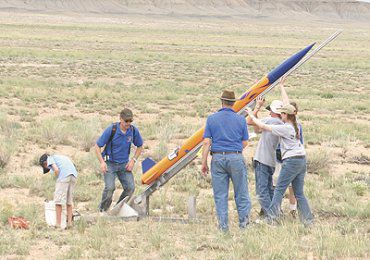The rockets were launched in the desert of Green River this week. Five colleges including: California State University – Long Beach, Arizona State University, Brigham Young University, University of Washington, and Seattle Central Community College all came to Green River to see if the rockets they worked on throughout the winter months would actually fly. This was a judged competition with several areas of criteria.
The first rocket was launched by California State University – Long Beach. It went up about 9,800 feet and the goal was 10,000 feet, it came gently back to the ground not far from the launch site, but then the wind picked up and took it for another ride. The retrieved rocket was a bit worse for the wear, but the team was very excited.
Next Arizona State’s rocket was launched, it didn’t go nearly as far as they had hoped, but it did return unscathed.
BYU had a bit of trouble getting their rocket off the ground, their igniter had a few problems and when it finally did lift off, it blew apart and then fell to the ground and burned.
This is the fourth year the rocket competition has taken place in Green River. The participants check in at the John Wesley Powell River History museum and the actual rocket launch takes place at the Green River White Sands Missile Base.
The desert near Green River is the perfect environment to explore the world of rockets. The White Sands Missile Base in New Mexico used Green River as a testing ground in the 1960s and 70s with the Athena and other rockets being launched from the Green River Test Site. But rocket launching is not just a part of Green River’s past, it is part of their future, too, as these modern rocket scientists and their students came to Green River to launch their creations.
The judges job is to rate each team on their projects and determine the winner of the fourth Annual Intercollegiate Rocket Launch Competition. Before the launch competition began, the teams were required to send the judges an 11 page paper summarizing their rocket design. They must also give a 45 minute oral presentation summarizing their rocket design. This oral presentation took place at the John Wesley Powell River History Museum meeting room.
The Environmental Sounding Rocket Association, in conjunction with Alliance Technical Systems (formerly Thiokol) sponsor the competition for budding engineers to display their talents. Many aerospace engineers come out to the competition to watch and take notes on the quality of engineers being turned out by the universities. The future of the aerospace industry will be in the hands of the graduates of today.
At the launch site, the teams construct their rockets with the aim of launching it and its 10 pound payload 10,000 feet in the air. In addition to the successful launch, the team is required to recover the rocket and it must be in reusable condition. The payload must not be harmed and recoverable also. Maximum points are given to the team whose rocket reaches exactly 10,000 feet in altitude.
A barometric altimeter is installed in the rocket to produce a continuous readout of altitude which allows the team on the ground to know the exact height reached by the rocket. Within one hour of the recovery of the rocket, the team must submit a printout of the altitude to the judges.
The professor said, “This competition is for students to show what they can do. This is the fourth annual competition and Green River has been good to us. We want this competition to grow and have many more teams.”
Rocket launch in Green River draws colleges

"The students and professors from Brigham Young University prepare their rocket for launch."
